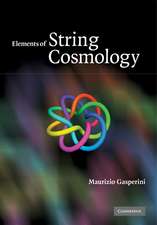The Evolution of The Milky Way: Astrophysics and Space Science Library, cartea 255
Editat de Francesca Matteucci, Franco Giovannellien Limba Engleză Paperback – 5 noi 2012
| Toate formatele și edițiile | Preț | Express |
|---|---|---|
| Paperback (1) | 960.93 lei 6-8 săpt. | |
| SPRINGER NETHERLANDS – 5 noi 2012 | 960.93 lei 6-8 săpt. | |
| Hardback (1) | 967.22 lei 6-8 săpt. | |
| SPRINGER NETHERLANDS – 31 ian 2001 | 967.22 lei 6-8 săpt. |
Din seria Astrophysics and Space Science Library
- 24%
 Preț: 799.08 lei
Preț: 799.08 lei - 15%
 Preț: 647.92 lei
Preț: 647.92 lei - 18%
 Preț: 983.81 lei
Preț: 983.81 lei - 18%
 Preț: 790.28 lei
Preț: 790.28 lei -
 Preț: 359.85 lei
Preț: 359.85 lei -
 Preț: 389.70 lei
Preț: 389.70 lei - 20%
 Preț: 691.13 lei
Preț: 691.13 lei - 20%
 Preț: 816.17 lei
Preț: 816.17 lei - 18%
 Preț: 1011.27 lei
Preț: 1011.27 lei -
 Preț: 402.56 lei
Preț: 402.56 lei - 15%
 Preț: 664.93 lei
Preț: 664.93 lei -
 Preț: 398.15 lei
Preț: 398.15 lei - 18%
 Preț: 954.77 lei
Preț: 954.77 lei -
 Preț: 411.04 lei
Preț: 411.04 lei - 18%
 Preț: 1225.31 lei
Preț: 1225.31 lei - 18%
 Preț: 1843.29 lei
Preț: 1843.29 lei -
 Preț: 393.13 lei
Preț: 393.13 lei -
 Preț: 400.26 lei
Preț: 400.26 lei - 18%
 Preț: 953.82 lei
Preț: 953.82 lei - 18%
 Preț: 960.61 lei
Preț: 960.61 lei -
 Preț: 398.35 lei
Preț: 398.35 lei -
 Preț: 390.84 lei
Preț: 390.84 lei -
 Preț: 413.76 lei
Preț: 413.76 lei -
 Preț: 416.64 lei
Preț: 416.64 lei - 18%
 Preț: 947.67 lei
Preț: 947.67 lei -
 Preț: 404.51 lei
Preț: 404.51 lei - 18%
 Preț: 956.50 lei
Preț: 956.50 lei -
 Preț: 403.75 lei
Preț: 403.75 lei - 18%
 Preț: 1229.40 lei
Preț: 1229.40 lei - 18%
 Preț: 1224.99 lei
Preț: 1224.99 lei -
 Preț: 404.29 lei
Preț: 404.29 lei - 15%
 Preț: 654.77 lei
Preț: 654.77 lei - 18%
 Preț: 1248.20 lei
Preț: 1248.20 lei - 18%
 Preț: 955.25 lei
Preț: 955.25 lei - 18%
 Preț: 1846.28 lei
Preț: 1846.28 lei - 18%
 Preț: 1233.06 lei
Preț: 1233.06 lei - 18%
 Preț: 1234.77 lei
Preț: 1234.77 lei
Preț: 960.93 lei
Preț vechi: 1171.86 lei
-18% Nou
Puncte Express: 1441
Preț estimativ în valută:
183.88€ • 192.47$ • 153.04£
183.88€ • 192.47$ • 153.04£
Carte tipărită la comandă
Livrare economică 31 martie-14 aprilie
Preluare comenzi: 021 569.72.76
Specificații
ISBN-13: 9789401037990
ISBN-10: 940103799X
Pagini: 644
Ilustrații: XVI, 624 p.
Dimensiuni: 160 x 240 x 34 mm
Greutate: 0.89 kg
Ediția:2000
Editura: SPRINGER NETHERLANDS
Colecția Springer
Seria Astrophysics and Space Science Library
Locul publicării:Dordrecht, Netherlands
ISBN-10: 940103799X
Pagini: 644
Ilustrații: XVI, 624 p.
Dimensiuni: 160 x 240 x 34 mm
Greutate: 0.89 kg
Ediția:2000
Editura: SPRINGER NETHERLANDS
Colecția Springer
Seria Astrophysics and Space Science Library
Locul publicării:Dordrecht, Netherlands
Public țintă
ResearchCuprins
The Chemical Evolution of the Milky Way: Some Important Facts.- S/¦Á/Fe Abundance Ratios in Galactic Metal Poor Stars.- S/?/Abundance Ratios in Halo Field Stars: is there a Globular Cluster Connection?.- Early Galactic Evolution of Carbon, Nitrogen and Oxygen.- The Origin and Kinematical Evolution of SMR Stars.- Abundances in Supernovae.- Obser-vations of Candidate SMR Stars.- Planetary Nebulae: Abundances and Abundance Gradients.- Planetary Nebulae as Probes of Stellar Evolution and Populations.- Clump Stars in the Solar Neighbourhood.- Mixing Along the Red Giant Branch in Metal-Poor Field Stars.- The Metal Abundance of Galactic Cepheids as Derived from their Pulsational Properties.- Wolf-Rayet Stars, Binaries, Black Holes.- The Evolution of Binaries.- The Origin of X-Ray Pulsars in Binary Systems.- Metal Abundances in Globular Clusters.- On the Globular Cluster IMF below 1M®.- The Effect of CNO and Enhanced a-Elements on Globular Cluster Stars.- HST-UV Observations of Stellar Clusters: Looking for BSS.- HST-WFPC2 Photometry of the Globular Cluster NGC288•Binary Systems, Blue Stragglers and Very Blue Stars.- Infrared Observations of Stellar Clusters.- Can Mira Variables Tell us the Chemical Abundances in Stellar Systems?.- Abundances in Open Star Clusters: What we have to work with.- Galactic Globular Clusters Relative Ages:Clues on the Milky Way Early Evolution.- Infrared Observations of Globular Clusters.- Absolute Magnitude of RR Lyrae in Globular Clusters from Pulsational Properties.- Galactic Globular Clusters as Calibrators of Synthetic Line Indices.- Old Open Clusters as Tracers of Galactic Evolution.- Abundances of Globular Clusters in the Galactic Bulge.- The Globular Clusters and Field Stars in the Galactic Bulge.- The Initial Mass Function of theGalactic Bulge down to ’ 0.15M®.- Radial Variables as Tracers of Stellar Populations.- Abundance Gradients along the Galactic Disk.- The Age of the Galactic Disk.- Compact High Velocity Clouds at High Resolutions.- The Present Rate of Supernovae.- The Role of Classical Novae in the Galactic Nucleo-synthesis.- Faint Stars in the Ursa Minor Dwarf Spheroidal Galaxy: Implications for the Stellar IMF.- Evolution of Heavy Elements in wCen: the Puzzle of s-Enrichments.- Stellar Evolution with Rotation.- The Explosive Yields of Massive Stars.- Asymptotic Giant Branch Stars.- Yields from Type la Supernovae.- The Evolution of Zero Metal Intermediate Mass Stars.- The Effect of External Pollution on the Evolution of Low-Mass Metal-Free Stars.- Explosive Nucleosynthesis of Massive Stars. The Effect of the Metallicity.- Chemical Yields from Low-and Intermediate-Mass Stars.- AGB Stars New Models: Lithium Production in the Galaxy and Magellanic Clouds.- Observational Constraints to the Evolution of Massive Star.- The Chemical Evolution of the Milky Way.- Reconstructing the Star Formation History of the Galaxy.- Inhomogeneous Chemical Evolution of the Galactic Halo.- Stellar Yields and Chemical Evolution.- The Influence of Nova Nucleosynthesis on the Chemical Evolution of the Galaxy.- The Evolution of the Milky Way Disk.- The effects of a Variable IMF on the Chemical Evolution of the Galaxy.- Metallicity Effects on Type Ia Supernovae and Galactic and Cosmic Chemical Evolution.- On the Abundance Gradients in the Galactic Disk.- Formation of Disk Galaxies: on the Angular Momentum Problem, the Tully-Fisher Relation and Magnetohydro-dynamics.- Has the IMF of EG’s Always been the Same?.- Concluding Remarks.- Concluding Address.















